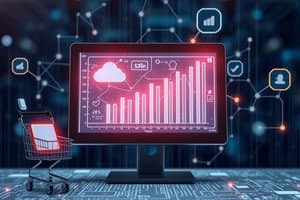Podcast
Questions and Answers
What defines the concept of electronic business?
What defines the concept of electronic business?
- Utilization of internet technologies to conduct business (correct)
- Offline marketing strategies
- Face-to-face transactions exclusively
- Traditional value chains without digital elements
Which of the following is a key benefit of electronic commerce?
Which of the following is a key benefit of electronic commerce?
- Extended distribution channels (correct)
- Reduced consumer information access
- Increased need for physical storefronts
- Higher transaction costs
What is meant by 'information asymmetry' in the context of electronic commerce?
What is meant by 'information asymmetry' in the context of electronic commerce?
- Products are consistently misrepresented
- One party has more crucial information than the other (correct)
- Information is irrelevant in electronic transactions
- Both parties have equal information in a transaction
Which characteristic does not contribute to the 'richness' of online communications?
Which characteristic does not contribute to the 'richness' of online communications?
How do digital payment systems enhance e-commerce?
How do digital payment systems enhance e-commerce?
Which online marketplace concept directly benefits from extended reach?
Which online marketplace concept directly benefits from extended reach?
What role do peer-to-peer payment systems play in electronic commerce?
What role do peer-to-peer payment systems play in electronic commerce?
What is a potential risk associated with electronic payment security?
What is a potential risk associated with electronic payment security?
Which feature of the Internet contributes to reduced network costs in e-commerce?
Which feature of the Internet contributes to reduced network costs in e-commerce?
What intrinsic advantage does electronic commerce have over traditional retail?
What intrinsic advantage does electronic commerce have over traditional retail?
What is a primary characteristic of a private industrial network?
What is a primary characteristic of a private industrial network?
Which option best defines a net marketplace?
Which option best defines a net marketplace?
What best describes third-party exchanges in business-to-business electronic commerce?
What best describes third-party exchanges in business-to-business electronic commerce?
What is a key feature of digital wallet systems?
What is a key feature of digital wallet systems?
What is a common challenge faced by electronic payment systems?
What is a common challenge faced by electronic payment systems?
Which of the following represents a peer-to-peer payment system?
Which of the following represents a peer-to-peer payment system?
Which payment system allows for payments based on accumulated micropayments?
Which payment system allows for payments based on accumulated micropayments?
How do intranets facilitate electronic business?
How do intranets facilitate electronic business?
What is a potential risk associated with business-to-business electronic commerce?
What is a potential risk associated with business-to-business electronic commerce?
Which of these is NOT a feature of electronic billing systems?
Which of these is NOT a feature of electronic billing systems?
What is a major advantage of using intranets in electronic business?
What is a major advantage of using intranets in electronic business?
Which of the following best describes a stored value payment system?
Which of the following best describes a stored value payment system?
What role do exchanges play in electronic commerce?
What role do exchanges play in electronic commerce?
Which of the following best describes Business-to-Business (B2B) electronic commerce?
Which of the following best describes Business-to-Business (B2B) electronic commerce?
What is the primary benefit of utilizing e-procurement in B2B electronic commerce?
What is the primary benefit of utilizing e-procurement in B2B electronic commerce?
What characterizes an online marketplace in the context of electronic business?
What characterizes an online marketplace in the context of electronic business?
How do digital payment systems enhance the efficiency of online transactions?
How do digital payment systems enhance the efficiency of online transactions?
What is a potential drawback of peer-to-peer payment systems?
What is a potential drawback of peer-to-peer payment systems?
Which of the following accurately describes electronic payment security measures?
Which of the following accurately describes electronic payment security measures?
What role do online service providers play in the electronic commerce ecosystem?
What role do online service providers play in the electronic commerce ecosystem?
What is a major benefit of disintermediation in customer-centered retailing?
What is a major benefit of disintermediation in customer-centered retailing?
Which statement best defines digital content providers in electronic business?
Which statement best defines digital content providers in electronic business?
What is the primary function of a syndicator in the context of online services?
What is the primary function of a syndicator in the context of online services?
What advantage does web personalization provide to online businesses?
What advantage does web personalization provide to online businesses?
In the context of electronic commerce, what does reintermediation involve?
In the context of electronic commerce, what does reintermediation involve?
Which type of electronic commerce allows consumers to sell goods directly to other consumers?
Which type of electronic commerce allows consumers to sell goods directly to other consumers?
Which of the following statements is true regarding web-based responses to customer inquiries?
Which of the following statements is true regarding web-based responses to customer inquiries?
Flashcards
Internet's role as digital infrastructure
Internet's role as digital infrastructure
The internet is becoming the primary way businesses operate digitally, providing universal access and 24/7 availability. It offers easier communication channels, and lowers costs associated with transactions and coordination.
Unbundling of information
Unbundling of information
The internet separates information about products and services from the physical product. This allows creating new business models that can offer more than just the product itself.
Information asymmetry
Information asymmetry
One party in a transaction has more essential information than another.
Internet's impact on info asymmetry
Internet's impact on info asymmetry
Signup and view all the flashcards
Richness
Richness
Signup and view all the flashcards
Reach
Reach
Signup and view all the flashcards
Virtual storefront
Virtual storefront
Signup and view all the flashcards
Private Industrial Network
Private Industrial Network
Signup and view all the flashcards
Net Marketplace
Net Marketplace
Signup and view all the flashcards
Exchanges
Exchanges
Signup and view all the flashcards
Digital Wallet
Digital Wallet
Signup and view all the flashcards
Digital Cash
Digital Cash
Signup and view all the flashcards
Intranets
Intranets
Signup and view all the flashcards
Extranets
Extranets
Signup and view all the flashcards
Business Process Integration
Business Process Integration
Signup and view all the flashcards
Electronic Commerce Payment Systems
Electronic Commerce Payment Systems
Signup and view all the flashcards
Electronic Commerce Information Flows
Electronic Commerce Information Flows
Signup and view all the flashcards
Information Broker
Information Broker
Signup and view all the flashcards
Transaction Broker
Transaction Broker
Signup and view all the flashcards
Online Marketplace
Online Marketplace
Signup and view all the flashcards
Content Provider
Content Provider
Signup and view all the flashcards
Online Service Provider
Online Service Provider
Signup and view all the flashcards
Virtual Community
Virtual Community
Signup and view all the flashcards
Portal
Portal
Signup and view all the flashcards
Syndicator
Syndicator
Signup and view all the flashcards
B2C (Business-to-Consumer)
B2C (Business-to-Consumer)
Signup and view all the flashcards
B2B (Business-to-Business)
B2B (Business-to-Business)
Signup and view all the flashcards
C2C (Consumer-to-Consumer)
C2C (Consumer-to-Consumer)
Signup and view all the flashcards
Disintermediation
Disintermediation
Signup and view all the flashcards
Reintermediation
Reintermediation
Signup and view all the flashcards
E-procurement
E-procurement
Signup and view all the flashcards
Study Notes
Chapter 4: The Digital Firm: Electronic Business and Electronic Commerce
- Chapter 4 focuses on the digital firm, electronic business, and electronic commerce.
- Objectives include understanding how internet technology has changed value propositions and business models.
- It also explores electronic commerce's impact on consumer retailing and business-to-business transactions.
- The chapter clarifies the key payment systems for electronic commerce.
- It examines how internet technology assists in internal and interorganizational business process management and coordination.
- Studying the major managerial and organizational challenges posed by electronic business and commerce is important.
Management Challenges
- Digitally integrating the enterprise demands a significant mindset shift.
- Developing a successful internet business model is crucial.
Internet Technology and the Digital Firm
- The internet is rapidly becoming the primary infrastructure choice.
- The internet provides a universal, user-friendly set of technologies and standards.
- Web sites are readily available 24/7.
- Distribution channels are broadened.
- Transaction costs and network/coordination costs decrease.
New Business Models and Value Propositions
- In the past, information about products/services was bundled with the physical value chain.
- Today, the internet has decoupled information from the traditional value chain, leading to new business models.
- Information asymmetry, where one party holds more essential information than the other, exists.
- The internet has reduced information asymmetry.
- Richness refers to the depth and detail of information available.
- Reach refers to the number of people a business can connect with and the number of products offered to those individuals.
- The internet fosters richer communication and broader reach.
- Internet technology's impact on the economics of information brings new levels of richness and reach.
Internet Business Models
- Virtual storefront: Direct selling of physical products to consumers/businesses.
- Information broker: Provides pricing/availability information, generating revenue from advertising or guiding buyers towards sellers.
- Transaction broker: Processes online transactions for a fee.
- Online marketplace: A digital platform where buyers and sellers converge.
- Content provider: Offers digital content (e.g., news) generating revenue from fees or advertising.
- Online service provider: Offers connectivity, leveraging revenue from fees, advertising, and informational resources.
- Virtual community: Facilitates online interactions among like-minded individuals.
- Portal: A primary entry point to the internet, providing specialized content and services.
- Syndicator: Aggregates content/applications for resale on third-party websites.
Electronic Commerce
- Categories of electronic commerce include business-to-consumer (B2C), business-to-business (B2B), and consumer-to-consumer (C2C).
Customer-Centered Retailing
- Disintermediation involves removing intermediaries in a value chain, leading to reduced customer costs.
- Reintermediation involves transferring intermediary functions to a new source, such as service hubs.
- Benefits of disintermediation for consumers showcase the cost savings from eliminating middlemen.
- Interactive marketing and presentation allows collection of customer information efficiently through website auditing tools, which are less expensive than surveys/focus groups.
- Personalization technologies offer customized content based on customer profiles and purchase histories, reducing the time spent in educating customers.
Customer Self-Service
- Web-based customer support is cheaper than phone support.
- Web-based self-service applications, like airline flight information websites are helpful.
- Traditional call centers are integrating with web-based technologies.
Business-to-Business Electronic Commerce
- Private industrial networks connect large firms with suppliers and partners via extranets, enabling sharing of product design, development, marketing, scheduling, inventory management, and communication.
- Private industrial networks are rapidly expanding B2B commerce.
- Net marketplaces (e-hubs) provide centralized Internet-based platforms for various buyers and sellers.
- Net marketplaces are industry owned or independent intermediaries, operating transaction-oriented models and deriving revenue from transaction and other services.
- Exchanges are third-party marketplaces connecting many suppliers and buyers, encouraging spot purchasing.
Electronic Commerce Payment Systems
-
Digital credit card systems facilitate secure credit card transactions over the internet.
-
A digital wallet stores credit card information, facilitating payment processes.
-
Accumulated balance digital payment systems aggregate micropayments as a debit balance to be later paid on credit cards/phone bills.
-
Stored value systems enables consumers to make instant payments using value stored in a digital account.
-
Digital cash is a digital form of currency used for micro-transactions and larger purchases.
-
Peer-to-peer payment systems facilitate payments to vendors that do not accept credit cards.
-
Digital checking enables electronic check processing/transactions using secure digital signatures.
-
Electronic billing systems allow for online and physical purchases to be processed electronically.
Electronic Commerce Information Flows
- Retailers communicate with the buyer through information, orders, service and support.
- Manufacturers/suppliers/distributors interact with their counterparts via purchases and bids.
- Banks facilitate credit/payment authorization, and electronic payment transfers.
How Intranets Support Electronic Business
- Intranets offer broad accessibility from various devices.
- Intranets can integrate with internal corporate systems and transaction data.
- Intranets foster interactive applications utilizing text, audio, and video.
- Intranets scale to accommodate larger or smaller computing demands.
- Intranets feature easy-to-use web interfaces.
- Intranets have low startup costs.
- Rich, dynamic information environments are characterized by intranets.
- Intranets reduce information distribution costs.
- Intranet application examples include finance/accounting, human resources, sales/marketing, and manufacturing/production.
Business Process Integration
- Pre-internet integration methods were costly and complex.
- Internet technology provides a more affordable approach to enterprise system design.
- Intranets foster improved coordination within internal business processes.
- Extranets aid in coordinating processes shared between businesses and external stakeholders, like customers/partners.
- Intranets support collaborative commerce
Management Challenges and Opportunities
- Unproven business models pose challenges.
- Business process requirements present integration complexities.
- Channel conflicts can arise from integrating new systems.
- Legal issues are inevitable during the transition to online business models.
- Issues regarding online trust, security, and privacy warrant considerations.
Case Study: Can the Music Industry Change Its Tune?
- The impact of the internet on the music industry and declining CD sales are subject to this case study.
- Students apply value chain and competitive forces models to the music recording industry.
- Assessing the internet’s role in the shifting value propositions/competitive landscapes of the music industry.
- Determining how much the internet has contributed to the decline of CD sales.
- Analyzing the industry's response to these changes, identifying management, organizational, and technological issues influenced by that response.
- Examining the industry's present business strategy to determine its viability.
Studying That Suits You
Use AI to generate personalized quizzes and flashcards to suit your learning preferences.




